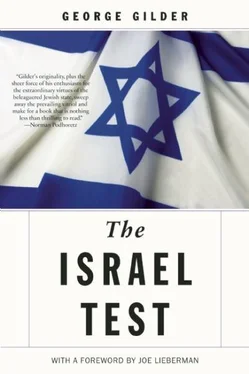After 1948, the history of Palestinian Arabs may be divided into three periods, each roughly two decades long: the postwar period from Israel’s founding through the war in 1967 when Gaza and Sinai were under Egyptian rule and the West Bank was ruled by Jordan; the period of Israeli administration of these territories between 1967 and 1990; and the recent era of the so-called “peace process” led by international organizations and the U.S. The statistical details remain cloudy and have provoked scores of academic brawls and millipedes of footnotes. But the historic dynamics of population, economic growth, and foreign aid are a matter not of statistical minutiæ but of orders of magnitude. The rough orders of magnitude, as exemplified the growth of the Arab population and its longevity, tell a story stunningly contrary to that purveyed through the conventional wisdom.
The only real Palestinian naqba came not in 1948 at the hands of Zionists, but in 1949, at the hands of foreign aid bureaucrats in the form of United Nations Relief and Works Agency for Palestine Refugees (UNRWA). In an unprecedented decision, applied to no other refugees on the face of the Earth, the UN extended its smothering embrace not only to the allegedly innocent Arab “victims” of the chaos of the 1948 war but also in perpetuity to all their descendants.
Like most welfare states, the UNRWA was formed less to provide for the good of its beneficiaries than to assuage the guilt of its creators. In a desire to compensate the Palestinians for their alleged victimization by the creation of the State of Israel, the international bureaucracies perpetrated and created a genuine and permanent victimization. Masked by a roughly $4 billion annual flood of outside aid to the Palestinian Arabs, the UN work of worldly charity has wreaked six decades of moral havoc.
The UNRWA effectively granted its benefactions only on the condition that the Palestinians never relinquish their dream of the complete destruction of the state of Israel. Otherwise, these generations of putative Palestinians could hardly qualify as “refugees.” Sixty years later, the UNRWA continues to underwrite and encourage murder, irredentism, terrorism, fecklessness and futility among the 1.4 million hapless souls who live in its 59 camps.
Financed by the U.S. and the European Union, as Michael S. Bernstam of Stanford’s Hoover Institution explained in Commentary in December, 2010, “UNRWA is still paying millions of refugees to perpetuate their refugee status, generation after generation, as they await their forcible return to the land inside the State of Israel…. UNRWA’s institutionalization of refugee-cum-military camps is,” wrote Bernstam, nothing less than “the principal obstacle to peace in the Middle East.”
The UNRWA perpetuates the notion of a “right of return” to the land. Yet this land scarcely counted as a desirable asset or a prize to be awarded to anyone before the Jews reclaimed it and made its economy valuable and its land capable of supporting life. The refugees’ forbears in many cases were more recent immigrants to Palestine than were the Jewish settlers.
“This is not the right of return,” writes Bernstam, “it is a claim of the right to retake …” But here even Bernstam slips on the rotten bananas of the conventional narrative. There is no “retake” or retrieval involved, but an utterly spurious claim of a right to seize the land from its lawful owners. “More than being detrimental to Israel, it is destructive for the Palestinians because it gives more belligerent groups, such as Hamas, an upper hand…”
A typical harvest of misconceived foreign aid, this tragic error is at the heart of the Palestinian imbroglio and extends the Palestinian grievance beyond Gaza and the West Bank into countries such as Jordan, Syria, and Lebanon that also host Palestinian camps.
The invidious ideology of Palestinian victimization by Israel, still guides the policies toward Israel in the majority of Western nations and in international organizations, blinding nearly all observers to the actual facts of economic life in the region. No one reading the literature could have any idea that throughout the three roughly 20-year economic eras following 1948, the Palestinians continued to benefit heavily from Israeli enterprise and prospered mightily compared to Arabs in other countries in the region. The indispensable cause and precursor of Arab enrichment and population growth were always the enabling successes of Israeli settlers. Before the settlers, there was no growth and little Arab immigration to Palestine.
The true test of a culture is what it accomplishes in advancing the human cause — what it creates rather than what it claims. The late economist Lord Peter Bauer devoted much of his distinguished career to the study of the corrosive effects of foreign aid. What might be termed a “Bauer syndrome” prevailed nearly everywhere that foreign aid became the chief source of incremental income. Typically, foreign aid flows to governments and tends to increase the power of the recipient government in relation to the private sector. Thus foreign aid fosters socialism, including, should the regime be so inclined, national socialism, and invariably, crony socialism.
As foreign aid eclipses entrepreneurial achievement as the dominant source of newfound income in a society, the influence of politics looms ever larger in the national life. A theater of grievance replaces a culture of economic advance. Displacing the peaceful outreach of commerce are seething concerns about domestic favoritism, international conspiracies, tribal loyalties, and personal betrayals. The more critical foreign aid becomes to a country’s economy, the more it tends to foster violence between ethnic groups and political factions. This dynamic governed much of the history of the Palestinians.
The first era of Palestinian economic history spanned the period between 1948 and 1967. During this period the Jordanians controlled the West Bank and the Egyptians controlled Gaza. In 1948, a total of nearly 600,000 Arabs lived in these Palestinian territories (not including those who remained in Israel proper). The most significant of these territories, the West Bank of the Jordan River (also known by its Biblical designations of Judea and Samaria), covers some 2,000 square miles of land. More than 500,000 Arabs lived in the West Bank in 1948. Gaza, the other territory, is a strip of land on the Mediterranean contiguous with Egypt, which is approximately 25 miles (40 kilometers) long and six miles (10 kilometers) wide that was home to almost 80,000 Arabs in 1948. As Hillel Halkin observed, “Jordan, Israel’s main military adversary in 1948, saw to it that the West Bank it annexed had not a Jew in it.” Similarly, Egypt would not permit Jews to live in Gaza.
In this first 2 0 -year phase, under Jordanian control, the Arab population of the West Bank increased by 2 0 percent, to some 600,000 by 1967, and the economy showed modest growth, with per capita income around $800. The population of Gaza rose fivefold to some 400,000, while the economy in Gaza stagnated under unofficial Egyptian rule and experienced an influx of Palestinian war refugees with their incumbent baggage of UN programs.
Many leading Palestinian entrepreneurs fled to Amman, Damascus, or Beirut, where they set up formidable machine shops and even banking and insurance firms. There are wealthy ex-Palestinians scattered throughout the Middle East. If economies are driven by the efforts of a relatively few exceptional entrepreneurs, most of the Palestinian “few” left their fellow Palestinians behind. Growth in the West Bank and Gaza was sluggish at best and no one in authority ever proposed creation of an Arab Palestinian state beyond the one already established in Jordan.
Читать дальше












